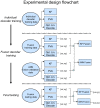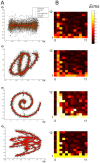Real-time decision fusion for multimodal neural prosthetic devices
- PMID: 20209151
- PMCID: PMC2830464
- DOI: 10.1371/journal.pone.0009493
Real-time decision fusion for multimodal neural prosthetic devices
Abstract
Background: The field of neural prosthetics aims to develop prosthetic limbs with a brain-computer interface (BCI) through which neural activity is decoded into movements. A natural extension of current research is the incorporation of neural activity from multiple modalities to more accurately estimate the user's intent. The challenge remains how to appropriately combine this information in real-time for a neural prosthetic device.
Methodology/principal findings: Here we propose a framework based on decision fusion, i.e., fusing predictions from several single-modality decoders to produce a more accurate device state estimate. We examine two algorithms for continuous variable decision fusion: the Kalman filter and artificial neural networks (ANNs). Using simulated cortical neural spike signals, we implemented several successful individual neural decoding algorithms, and tested the capabilities of each fusion method in the context of decoding 2-dimensional endpoint trajectories of a neural prosthetic arm. Extensively testing these methods on random trajectories, we find that on average both the Kalman filter and ANNs successfully fuse the individual decoder estimates to produce more accurate predictions.
Conclusions: Our results reveal that a fusion-based approach has the potential to improve prediction accuracy over individual decoders of varying quality, and we hope that this work will encourage multimodal neural prosthetics experiments in the future.
Conflict of interest statement
Figures





Similar articles
-
Bayesian population decoding of motor cortical activity using a Kalman filter.Neural Comput. 2006 Jan;18(1):80-118. doi: 10.1162/089976606774841585. Neural Comput. 2006. PMID: 16354382
-
Shared Prosthetic Control Based on Multiple Movement Intent Decoders.IEEE Trans Biomed Eng. 2021 May;68(5):1547-1556. doi: 10.1109/TBME.2020.3045351. Epub 2021 Apr 21. IEEE Trans Biomed Eng. 2021. PMID: 33326374
-
Decoding Three-Dimensional Trajectory of Executed and Imagined Arm Movements From Electroencephalogram Signals.IEEE Trans Neural Syst Rehabil Eng. 2015 Sep;23(5):867-76. doi: 10.1109/TNSRE.2014.2375879. Epub 2014 Dec 2. IEEE Trans Neural Syst Rehabil Eng. 2015. PMID: 25474811
-
Signal acquisition and analysis for cortical control of neuroprosthetics.Curr Opin Neurobiol. 2004 Dec;14(6):758-62. doi: 10.1016/j.conb.2004.10.013. Curr Opin Neurobiol. 2004. PMID: 15582380 Review.
-
Cortical neural prosthetics.Annu Rev Neurosci. 2004;27:487-507. doi: 10.1146/annurev.neuro.27.070203.144233. Annu Rev Neurosci. 2004. PMID: 15217341 Review.
Cited by
-
Signal Generation, Acquisition, and Processing in Brain Machine Interfaces: A Unified Review.Front Neurosci. 2021 Sep 13;15:728178. doi: 10.3389/fnins.2021.728178. eCollection 2021. Front Neurosci. 2021. PMID: 34588951 Free PMC article. Review.
-
Decision fusion in healthcare and medicine: a narrative review.Mhealth. 2022 Jan 20;8:8. doi: 10.21037/mhealth-21-15. eCollection 2022. Mhealth. 2022. PMID: 35178439 Free PMC article. Review.
-
Multi-Channel Neural Recording Implants: A Review.Sensors (Basel). 2020 Feb 7;20(3):904. doi: 10.3390/s20030904. Sensors (Basel). 2020. PMID: 32046233 Free PMC article. Review.
-
Recent advances in neural recording microsystems.Sensors (Basel). 2011;11(5):4572-97. doi: 10.3390/s110504572. Epub 2011 Apr 27. Sensors (Basel). 2011. PMID: 22163863 Free PMC article. Review.
References
-
- Dillingham TR, Pezzin LE, MacKenzie EJ. Limb amputation and limb deficiency: epidemiology and recent trends in the United States. South Med J. 2002;95:875–883. - PubMed
-
- Ziegler-Graham K, MacKenzie EJ, Ephraim PL, Travison TG, Brookmeyer R. Estimating the prevalence of limb loss in the United States: 2005 to 2050. Arch Phys Med Rehabil. 2008;89:422–429. - PubMed
-
- Nawrot MP, Boucsein C, Rodriguez Molina V, Riehle A, Aertsen A, et al. Measurement of variability dynamics in cortical spike trains. J Neurosci Methods. 2008;169:374–390. - PubMed
-
- Banerjee A, Series P, Pouget A. Dynamical constraints on using precise spike timing to compute in recurrent cortical networks. Neural Comput. 2008;20:974–993. - PubMed
-
- Scherberger H, Jarvis MR, Andersen RA. Cortical local field potential encodes movement intentions in the posterior parietal cortex. Neuron. 2005;46:347–354. - PubMed
Publication types
MeSH terms
LinkOut - more resources
Full Text Sources

